Can photocells (the PN junctions) be stacked (3) on top of each other (not just side-by-side) to let each PN junction produce electrical energy from the visible light, Infrared (IR) and ultraviolet light (UV)?

- 11
- 1
-
Depends on how transparent they are. – Ignacio Vazquez-Abrams Jul 17 '17 at 17:09
-
1If you want more energy per area, then it might be wise to put them like this \/\/\/\/\/\/\/\/ instead of ---------------- – Harry Svensson Jul 17 '17 at 17:20
1 Answers
Yes, they can. This is called a multi-junction solar cell. From the Wikipedia article:
Currently, the best lab examples of traditional crystalline silicon solar cells have efficiencies between 20% and 25%, while lab examples of multi-junction cells have demonstrated performance over 46% under concentrated sunlight. Commercial examples of tandem cells are widely available at 30% under one-sun illumination, and improve to around 40% under concentrated sunlight. However, this efficiency is gained at the cost of increased complexity and manufacturing price. To date, their higher price and higher price-to-performance ratio have limited their use to special roles, notably in aerospace where their high power-to-weight ratio is desirable.
The individual junctions are not connected in parallel, as you propose, but in series.
On “transparency”:
Conveniently, light of a particular wavelength does not interact strongly with materials that are of bigger bandgap. This means that you can make a multi-junction cell by layering the different materials on top of each other, shortest wavelengths (biggest bandgap) on the "top" and increasing through the body of the cell.
- 7,444
- 1
- 25
- 44
-
Could fiber optic cable be used to feed light to multi-junction solar cell, and still have a good theoretical efficiency? – Bill Jul 17 '17 at 19:58
-
@Bill That's a further question which I cannot help you with. Posting questions in comments isn't a good idea because fewer people will see them. – Kevin Reid Jul 17 '17 at 20:57